Managing your career journey: How to build a career development plan
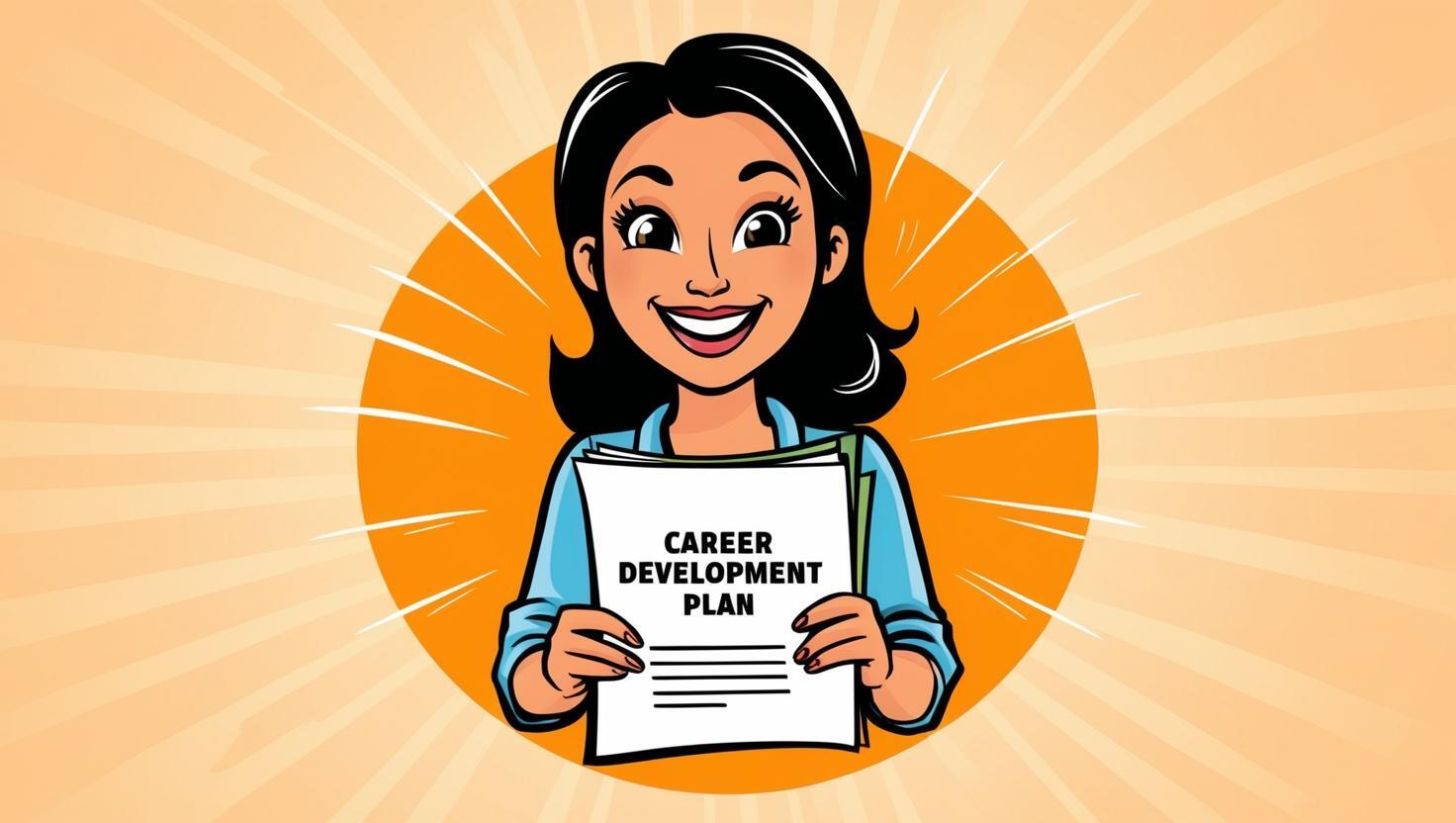
Happy new 2025 year to Women Coding Community!
The beginning of a new year is an exciting time and a great opportunity to take a step back and reflect on your career journey. A great tool to capture your reflections and close any associated gaps is a Career Development Plan (CDP). CDP is your personalised strategy which you define and use to achieve your career goals. It outlines skills and actions necessary to progress a career over a specific period.
In this blog post I am sharing ideas on how to build one to ensure it adds value to your career journey.
There is no one set approach to building CDP, but it is a common practice to include the following steps:
- Step 1: Determining a type of CDP.
- Step 2: Self-assessing.
- Step 3: Setting objectives.
- Step 4: Identifying actions.
- Step 5: Monitoring and tracking progress.
The above steps are reflected in the below template which we are going to fill in together as we go through the steps in more detail:
The CDP template was created by the author in PowerPoint, which can be accessible here.
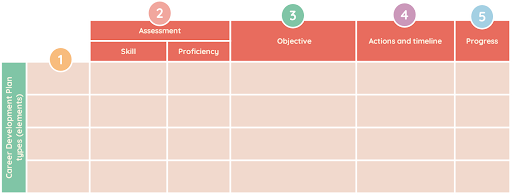
Step 1: Determining a type of CDP
Start with reflecting on what you are trying to achieve to determine a type and elements of your CDP.
There is no perfect template for a career development plan. It’s type and content depend on what you are trying to achieve. Some of the types of a CDP could include:
- Long (two to five years) or a short-term (monthly, quarterly, and annual) capturing tactical actions or a strategic long-term vision.
- A CDP can be general capturing multiple development areas or it can be specific to a particular skill, role, job or one objective.
- It can also be specific to organisation that you work or aspire to join.
A common recommendation is to use different types as a combination. For example (see the table below), you can create an annual CDP that captures your personal aspirations, skills you are looking to develop in your current role, skills relevant to your wider organisation, and more general industry related skills.
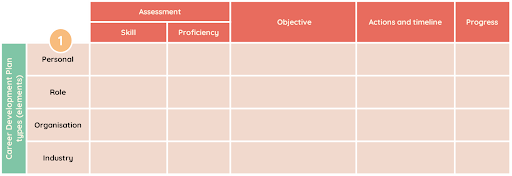
Step 2: Self-assessing
Assess your current skills, strengths, interests, values, and areas of improvement.
- Career goals: Ask yourself about your career goals, where do you see yourself next year and in next five years, think about what matters to you when it comes to your career and professional fulfilment and happiness.
- Industry trends: It is crucial to be aware of current industry trends including emerging technologies and innovation and geo-politics. Have a think about what matters in today’s world and what would you like to be a part of. Perhaps, there are some innovations that you are interested and would like to build associated skills, such as artificial intelligence and robotics.
- Skill development: Think about specific skills that require development, which perhaps have been suggested by your manager or a mentor.
- Resources and support: Also assess resources and support available to you, like free training or training available through your current organisation, and do not forget your network to give you advice! Once you determined which skills you want to focus on, assess them and apply proficiency level (see the table below and proficiency level descriptions as an example). This helps to benchmark your current skill level and track progress.
In our CDP below I include public speaking which I want to improve on a personal level. As a part of my role, I want to continue developing my coding skills. I also acknowledge that in my organisation risk management is taken very seriously and to succeed on organisational level I should work on practicing risk management more proactively. I also acknowledge that when it comes to my career goals, I see myself working in the financial services sector in the long run, hence I must be more immersed in it and understand associated trends and innovations.
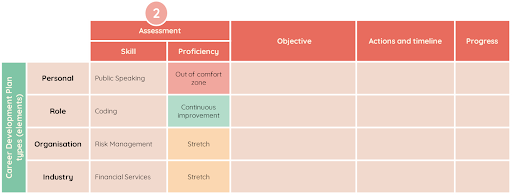
- Continuous improvement: a steady and incremental enhancement of skills, processes, or performance over time building upon existing strengths
- Stretch: taking on a challenge which is moderately above your current skill level requiring effort, adaptation, and learning.
- Out of comfort zone: operating in unfamiliar or highly challenging settings which demands a leap in capabilities, adaptability, and mindset.
Step 3: Setting objectives
Define what needs to be done, when and how it is measured.
One of the most common approaches to setting objectives is SMART criteria. SMART goals are commonly used in project management, performance evaluations, and personal development to ensure that objectives are well-defined and attainable.
SMART stands for:- Specific: The objective should be clear and specific.
- Measurable: The objective should have criteria to measure progress and success.
- Achievable: The objective should be realistic and attainable, given the available resources.
- Relevant: The objective should align with broader business or personal goals.
- Time-bound: The objective should have a clear deadline or timeframe.
I have formulated a SMART objective for public speaking, which is a skill we determined for personal dimension of our CDP, as following:
I will improve my public speaking skills by attending three workshops, and practicing regularly over the next 12 months, and delivering five presentations to audiences of 50+ people, with measurable improvements tracked through peer feedback and self-assessment.
Let’s break it down according to each requirement to ensure it is SMART:
SMART stands for:- Specific: Deliver clear, confident presentations to audiences of 50+ people.
- Measurable: Tracking the number of presentations delivered, receiving feedback, and assessing my improvement in reducing filler words and maintaining eye contact.
- Achievable: Achievable through attending public speaking workshops, practicing regularly in front of small groups, and seeking constructive feedback.
- Relevant: It is crucial to my career growth as it will help me present ideas effectively in meetings, conferences, and networking event
- Time-bound: I will achieve this within 12 months.
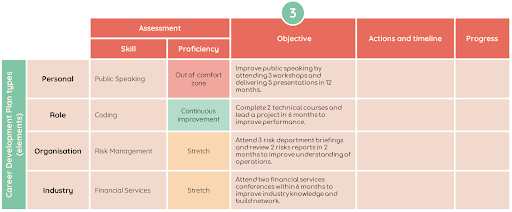
Outline specific, actionable steps to achieve your career objectives.
Break down your objectives into smaller, manageable actions or milestones. Brainstorm actions that are required to achieve your objective and close the gaps identified during your self-assessment. If you are building a detailed plan, you also may find it useful to consider sub-actions.
When deciding on actions consider the following depending on each skill improvement:
- Soft and technical skills required to achieve objectives.
- Which volunteering, cross functional roles/responsibilities, networking and industry exposure such as conferences, events, and workshops enable achievement of your objectives.
- Tools or software that can be helpful, which resource your company provides and what is useful online, also how you could utilise your network for example a mentor, peers, and online engagements.
Then prioritise and set up a timeline for actions, organise them by week, month, or quarter.
The below example provides quarterly actions against each objective.
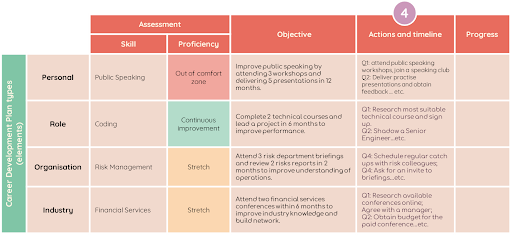
Step 5: Monitoring and tracking progress
Regularly review and update the plan to ensure it stays relevant and aligned with changing goals.
Tracking is key as your CDP and associated objectives and actions are not static and need to be updated on a need basis.
When you track your progress consider the following:
- Regular self-evaluation: Track your progress, review your plan, and adjust actions if certain tasks are no longer relevant or if new opportunities arise.
- Adapt to feedback:Use feedback from managers, mentors, or peers to refine your actions and make necessary adjustments.
You can track using different methods including by achieving milestones, measurable indicators (e.g. number of presentations and workshops), benchmark of industry standard or past performance, quantitative metrics such as percentage completed and productivity levels, and qualitative metrics such as positive feedback and customer satisfaction.
For our CDP I am using quantitative metrics of percentage completed for each skill requiring improvement.
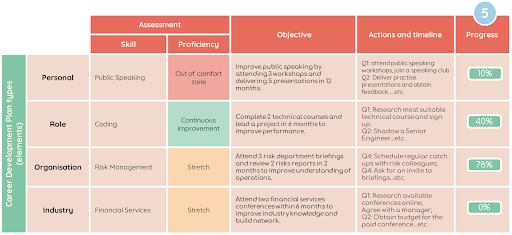
Additional overarching step which needs to be considered is collecting feedback. Using your network to get different perspectives, seek input, encouragement, and advice adds an immense value to your CDP. Think about your formal and informal mentor, managers, peers, and your friends. Schedule regular meetings and 1:1s to discuss your plan and aspirations. Continuously ask feedback especially considering any changes to determine areas for growth, share learnings, experience, and common challenges and opportunities.
At Women Coding Community we have numerous initiatives to support your career journey. One of such initiatives is a Career Club which we are running every month – we are looking forward to having you there.
Good luck with your plan!
If you have any questions, feel free to connect with me via LinkedIn.